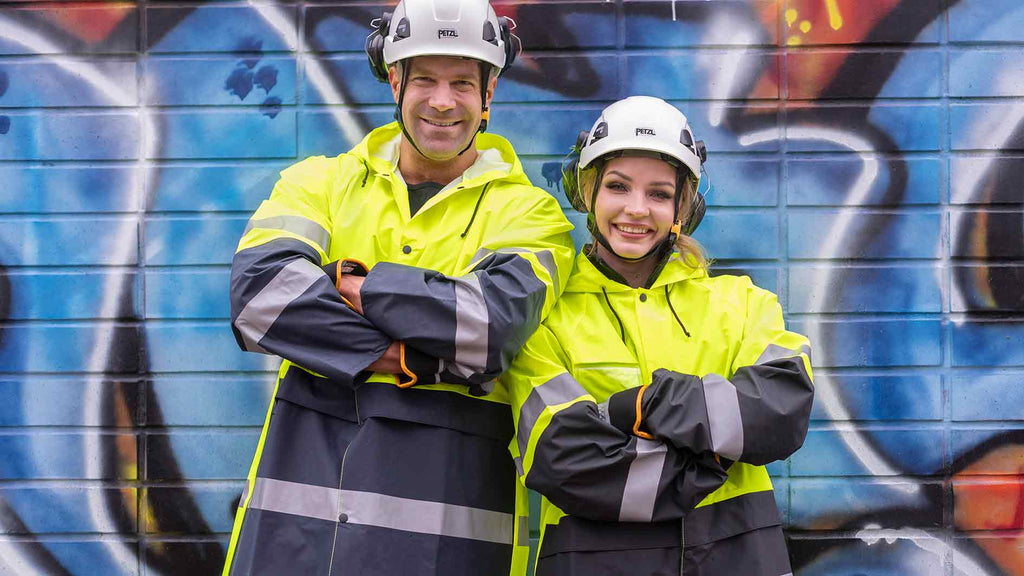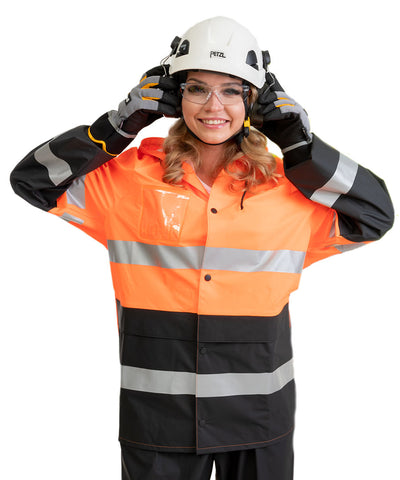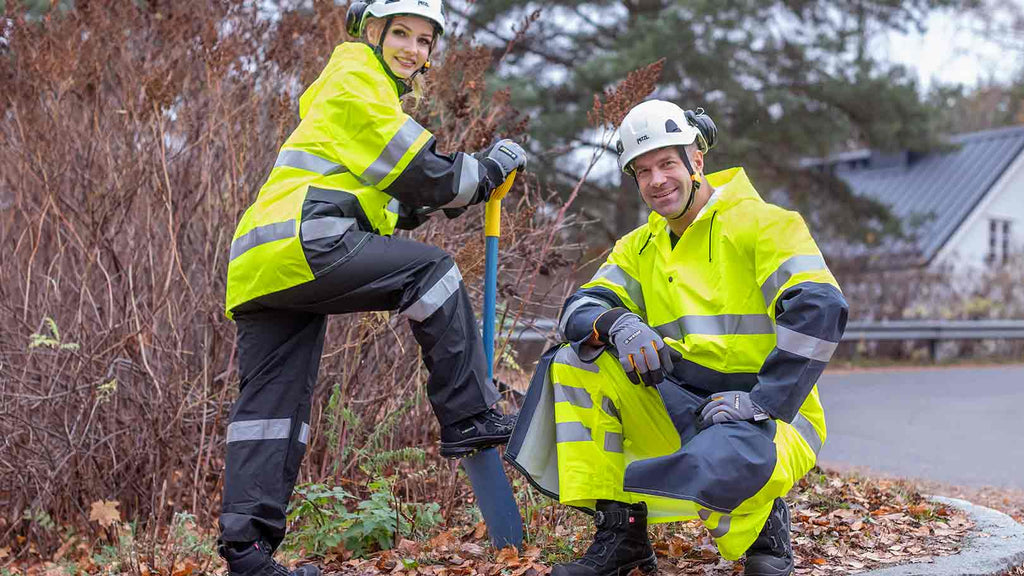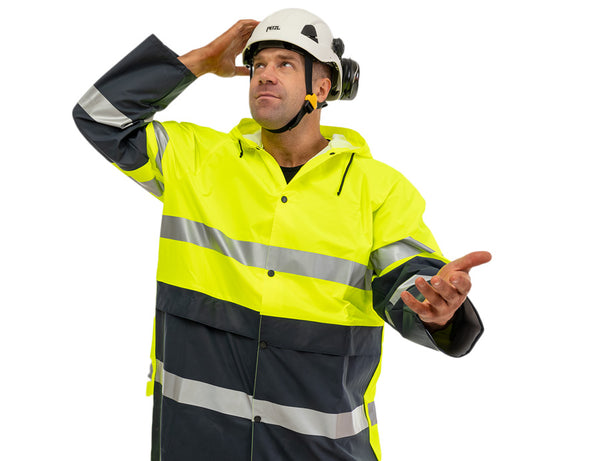Work clothes for rain and wind – shell and rain clothes

You should prepare for a rainy working day with rain-resistant equipment. Shell and rainwear are used on rainy days or in humid conditions to protect against rain and moisture. It is important to choose the right kind of work clothes to stay dry and to work comfortably even in wet and rainy weather.
Waterproof shell jackets and trousers offer an alternative to traditional windbreakers and rainwear. Shell products not only keep water on the outside, but they also breathe and remove moisture from the inside. Although shell clothing is popular and feels superior compared to traditional rainwear, it must be remembered that a simple rain jacket or trousers still has its rightful place as workwear.
Shell clothes are suitable for an active working day

Shell clothes are protective clothes that are intended as the top layer. It is important to wear warm layers under the outerwear because the outerwear itself only serves as protection against wind and rain. They are designed to work like a shell, i.e. keep the heat inside, let moisture out and prevent wind and water from penetrating inside. Read more about dressing in layers.
Shell clothes protect against wind and water. They usually consist of two layers: a surface fabric that repels water, and a membrane that prevents water from seeping through. This membrane is usually a breathable material that allows air to circulate inside the garment. The film laminated to the outer fabric of the shell garment allows moisture to evaporate from the inside to the outside but prevents water from entering from the outside with its microscopic pores. The water will bubble on the surface of the membrane. The membrane starts to work against water when the surface fabric is completely soaked through. Different types of membranes are available, and the membrane can influence both the product's properties and the price.
The shell clothes have taped seams so that water does not get in at the seams. All shell garments have a lining that protects the thin membrane. The lining material can be either a separate mesh or fabric lining, or the lining can be laminated into the membrane and surface fabric.
The membrane of the shell garment lets the moisture out. This is especially important so that moisture does not stay inside the garment and cause discomfort. In addition to being wind and waterproof, shell clothes are also usually light. They are great options for rainy days. If you are actively working in the rain or wind, shell clothes are the best choice. They keep you dry and prevent the clothes closer to the skin from getting completely wet from sweat.
Traditional rainwear for a perfectly waterproof working day

Traditional rainwear is made of polyurethane and is highly waterproof. They offer guaranteed protection against rain. You'll stay dry, no matter how hard it rains. However, in older models, the seams are not taped, so they can leak through the holes. In newer models, this problem has been fixed by taping the seams. Although traditional rain clothes are cheap and moderately durable, in long-term use they can start to get wet from the inside when sweating.
Rainwear is designed to keep us dry in heavy rain and strong winds. These clothes are usually made of a completely waterproof material that prevents water from penetrating through the garment. Rainwear normally also has a hood that protects against rain and wind. A useful feature of most rain gear is a snap fastener that allows quick donning and doffing, which is handy during unexpected downpours.
Work clothes for the rain - rain or shell clothes?
Shell and rainwear are different and designed for different situations. Well-breathable membrane materials make shell clothes more versatile and comfortable than rain clothes. Nowadays, the shell jacket has become a universal jacket that can be used everywhere and can provide as good protection from the rain as traditional raincoats. Shell clothes are usually lighter and more breathable, so they are better suited for e.g. for protection from drizzle and moisture. Rainwear, on the other hand, is designed to protect against heavy rain and strong winds. Each garment is precisely designed for a specific purpose, so it is important to choose the right type of garment for the right purpose.
Our warning rain and shell clothes have the standards EN ISO 20471 and EN 343. Shell clothes are fully taped, waterproof and have good breathability. Check out rain and shell clothing here.

Water resistance – waterproof or water repellent?
Various tests help manufacturers demonstrate the garment's ability to keep water out of the garment. The manufacturers declare the waterproofness of the clothes, and if the garment is waterproof, it can keep the water drops outside. Most manufacturers test their products, so raincoats or shell jackets that are declared waterproof can be trusted to protect you even from heavy rain. Water-repellent jackets can protect from light rain for a while, but in heavier rain these materials are not enough to keep you dry.
A waterproof material is one that prevents water from passing through it. It can be, for example, a waterproof membrane or layer placed on or under the surface of the garment or material. The waterproof material is designed to prevent water from seeping through and keep you dry. A water-repellent material does not prevent water from passing through it, but it does prevent water from being absorbed into the material. Such a material repels water, so water forms droplets on the surface of the material and runs off it, instead of being absorbed into the material. The water-repellent material can be, for example, a treatment agent applied to the fabric or an inherent property of the fabric that is designed to keep the material dry and prevent moisture absorption. The water-repellent material is therefore not completely waterproof, but it helps keep you dry in light rain or humid conditions.
The value of the water column indicates the water resistance of the material

The water column describes the pressure that a textile fabric can withstand without water getting on the inside. The value indicates the water resistance of the fabric, i.e. it is the water resistance measured in the laboratory. It tells you how much pressure the material can withstand before water starts to seep through it. The water column is always stated in millimetres and is measured from the top of the fabric using a tube in a horizontal position. A sample cut from the material is placed on the upper end of the pipe, and water is added to the lower end of the pipe under pressure until the material begins to permeate moisture.
In general, a material with a value of at least 1000 mm is considered waterproof in normal use. The higher the value of the water column, the more the material can withstand water pressure and is therefore more waterproof. A value of 10,000 mm already holds heavy rain. However, the value of the water column does not tell the whole truth about the material's water resistance, because the material's seams, zippers and other details can leak, even if the material's water column value is high.
You can find Image Wear work clothes for rain and wind here.








